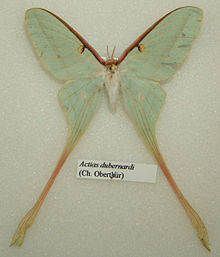Actias dubernardi
This article has been registered in the quality assurance biology for improvement due to formal or content-related deficiencies . This is done in order to bring the quality of the biology articles to an acceptable level. Please help improve this article! Articles that are not significantly improved can be deleted if necessary.
Read the more detailed information in the minimum requirements for biology articles .
| Actias dubernardi | ||||||||||||
|---|---|---|---|---|---|---|---|---|---|---|---|---|

male |
||||||||||||
| Systematics | ||||||||||||
|
||||||||||||
| Scientific name | ||||||||||||
| Actias dubernardi | ||||||||||||
| ( Oberthür , 1897) |
Actias dubernardi is a butterfly (moth) from the family of the peacock moth(Saturniidae).
features
The moths reach a wingspan of up to 15 centimeters. The wings of the males are purple-red and yellow-green, in the females they are pale green. The females resemble Actias luna , but have longer wing tails.
The eggs are quite large for Actias at 2.6 × 1.55 × 1.3 mm , flattened ovoid and dark white-gray in color. They are attached individually with the flattened side to needles of the food plant. A bred female produced only 96 pieces in total. The newly hatched caterpillars in the first instar (L1) are 5.5 to 6.0 mm long, their basic color is black, only the appendages on the back (scoli), the posterior ventral feet and the anal plate are ocher yellow and become darker after about 30 minutes . In the second stage the caterpillar is colored red. In the higher stages it is dark green with silver spots. Seen alone, it seems to be very strikingly colored, but between the needles of its food trees, which are hung with glittering dewdrops every day, the animals become practically invisible.
Occurrence
Actias dubernardi occurs in the cooler mountains of Southeast Asia and China .
biology
As with many species of peacock moth, this caterpillar also spins a cocoon . Depending on the temperature, the pupae will rest for 6–10 weeks. Since the species also occurs in frosty areas, the last generation of the year overwinters as a pupa in the moss or leaves on the forest floor. There it is protected from low temperatures and hatches in April / May of the next year.
The caterpillars feed on pines ( Pinus ) in nature , but also on larches ( Larix ) and Nordmann fir ( Abies nordmanniana ) in breeding . Like many other Saturniidae, they spin a cocoon of silk. The moths live a maximum of ten days because, like all Saturniidae, they cannot eat any food and the moth stage is only used for reproduction.
Individual evidence
- ↑ Stefan Naumann: Notes on Actias dubernardi (Oberthür, 1897), with description of the early instars (Lepidoptera: Saturniidae). In: News of the Entomological Association Apollo , NF 27 (1/2), S 9–16, 2006. ( Online )
Web links
- Saarland Butterfly Forum - Breeding Report ( Memento from February 6, 2010 in the Internet Archive )
- http://www.actias.de/p64956-actias-dubernardi-chinesischer-mondspinner-saturniidae.html?highlight=Actias+dubernardi#post64956
- http://lepidoptera.jimdo.com/zuchtberichte/lepidoptera-schmetterlinge/actias-dubernardi/
